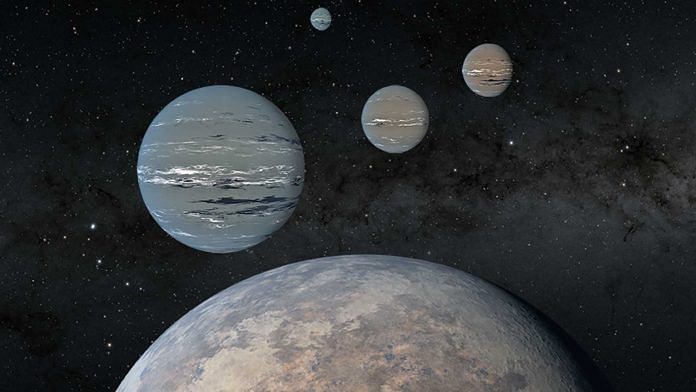Bengaluru: A new study in the US has discovered a multi-planetary system, which researchers say could be an ideal target for studying planetary evolution and exoplanetary atmospheres.
The study has been conducted by Tansu Daylan, a postdoctoral researcher at Massachusetts Institute of Technology’s Kavli Institute for Astrophysics and Space Research, and two high schoolers Kartik Pinglé (16) and Jasmine Wright (18), who were a part of the Student Research Mentoring Program (SRMP) at the Harvard-Smithsonian Center for Astrophysics (CfA) and the MIT.
According to the study, the multi-planetary system is home to a rocky ‘super-earth’ and three ‘sub-Neptunes’ orbiting around a bright sun-like star just over 200 light years away.
The researchers say the sizes of planets in the system, the similarity of the rocky planet to earth, and the similarity of the host star (HD 108236) to our Sun, makes it ideal to study planetary evolution.
The discovery was made using NASA’s Transiting Exoplanet Survey Satellite (TESS) space telescope that is designed to search for exoplanets. The peer-reviewed findings were published in The Astronomical Journal this week.
Also read: ‘Sextuply-eclipsing’ — Astronomers discover a six-star system that eclipses one another
Planetary laboratory
According to the study, the innermost planet orbiting the HD 108236 star (also called TOI-1233) could possibly be a rocky planet. The planet has been named HD 108236b and has a radius 1.6 times that of the Earth.
The planet has been categorised as a ‘super-earth’, which is the tag given to planets whose radii are between 0.8 to 2 times that of earth.
The researchers say the outer three planets are gaseous ‘mini-Neptunes’ or ‘sub-Neptunes’ — smaller in size than Neptune but bigger than twice the radius of earth — having radii of 2.1, 2.7 and 3.1 times that of the Earth.
Compared to our solar system, the four planets orbit extremely close to the host star, with orbital periods of 3.8 days, 6.2 days, 14.2 days, and 19.6 days respectively. In comparison, the solar system’s innermost planet, Mercury, takes 88 days while Neptune takes 165 years to complete one orbit around the sun.
What makes this system very interesting to astronomers is that the radius of the innermost rocky planet falls within a ‘radius valley’ of observed exoplanets — most super-Earths and sub-Neptunes are found very close to the extreme ends of their radii, but not many have been found in the mid-range between these two sizes.
The hot super-earth is one of the few that falls within this gap.
The researchers speculate that this likely was caused by the process of photoevaporation, whereby volatile gases in a (rocky) planet’s atmosphere evaporate, due to being so close to their host stars, leaving behind an exposed rocky core. The theory is supported by other planets in the system too, whose radii fit close to expected results from photoevaporation.
Studying masses and atmosphere
The planets were all discovered through the transit method, where the light from a star is dimmed or blocked to human view when a planet moves in front of it, enabling us to deduce the size or radius of the transiting planet.
“HD 108236 is the brightest Sun-like star in the visual band known to host four or more transiting exoplanets,” lead researcher Daylan told ThePrint. “With a visual magnitude of 9.2, the bright host star makes the transiting planets favorable targets for mass measurements and atmospheric characterisation via transmission spectroscopy.”
Since the star is so bright, any transiting planet causes a remarkably large change in brightness, and owing to how close the system is to us, provides a special opportunity into understanding these planets better with richer, clearer data.
Additionally, unlike our solar system where the planets are spaced very far apart, the system holds its four planets tightly together.
“The planets span a broad range of radii and equilibrium temperatures, originate from the same protoplanetary disk, and share a common history of stellar insolation,” explained Daylan. This provides an opportunity to compare and contrast the planets, both with each other as well as other planetary systems including our own.
Also read: For the first time ever, astronomers are witnessing a galaxy’s ‘death’ as it’s happening
System to be studied
Over the next few years, scientists expect the system to be studied by both the Hubble Space Telescope and the upcoming James Webb Space Telescope, which will help analyse their atmospheres.
The system might also likely harbour more planets that have not yet been discovered. Another team has already discovered a fifth planet using the Characterising Exoplanet Satellite (CHEOPS), which takes 29 days to orbit the star.
Daylan said his team is now working on determining the masses and compositions of the planets in the system. The team is also using other methods to hunt for planets, such as the radial velocity method, where the gravitational tug of a planet is also felt on its star and can be observed, helping us understand the masses of planets.
“Our species has long been contemplating planets beyond our solar system,” said Daylan. “In recent years, an extensive research programme has produced a catalog of more than four thousand exoplanets and contextualised our planet Earth and the solar system, while giving us observables to test models of planet formation and evolution.”
Also read: Mars, Moon & a fresh pair of eyes in the sky — the big space missions planned for 2021



